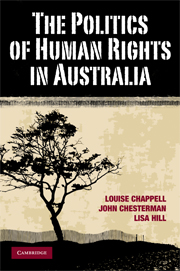Book contents
- Frontmatter
- Contents
- Acknowledgements
- List of abbreviations
- Introduction
- 1 Human Rights
- 2 Protecting Human Rights
- 3 A Bill of Rights?
- 4 Electoral Rights in Australia
- 5 The Rights of Indigenous Australians
- 6 Gender and Sexuality Rights
- 7 Refugees
- 8 Civil and Political Rights in an Age of Terror
- Notes
- Index
- References
3 - A Bill of Rights?
- Frontmatter
- Contents
- Acknowledgements
- List of abbreviations
- Introduction
- 1 Human Rights
- 2 Protecting Human Rights
- 3 A Bill of Rights?
- 4 Electoral Rights in Australia
- 5 The Rights of Indigenous Australians
- 6 Gender and Sexuality Rights
- 7 Refugees
- 8 Civil and Political Rights in an Age of Terror
- Notes
- Index
- References
Summary
Australia is the only Western democracy without a bill of rights. Whereas similar countries such as the USA, Canada, the Netherlands, France, Italy, the United Kingdom and New Zealand have each enacted either a constitutionally entrenched or statutory bill of rights, Australia has remained steadfastly opposed to developing a bill of rights. Some commentators fear that, without one, Australian human rights will suffer because our system will be out of step with more advanced rights jurisprudence in those countries that do have a bill of rights (see Brennan 2007). However, being out of step with practice elsewhere is not, in itself, a reason for change; it needs to be determined whether Australia needs such an instrument (see Campbell 2006, 325; Allan 2003, 176).
Currently, rights are not adequately protected in Australia; while certain majority rights are quite well protected through parliamentary mechanisms, minority rights are vulnerable. The consequences of this pattern for certain Australians, including many women, homosexuals, refugees and prisoners have been detrimental, and for Aboriginal Australians, they have been nothing short of devastating.
But despite having found the Australian rights framework wanting, we still need to consider whether a bill of rights is the answer to the problem. Bills of rights in and of themselves do not provide better government services or guarantee equality of outcomes but if taken seriously and carried into law and practice in the settings where they operate, they demonstrably make rights more secure.
- Type
- Chapter
- Information
- The Politics of Human Rights in Australia , pp. 62 - 84Publisher: Cambridge University PressPrint publication year: 2009



